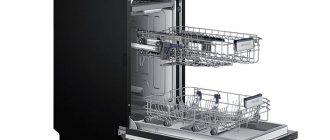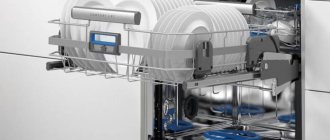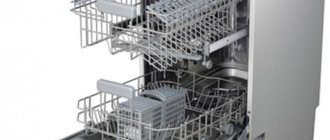A little history of the first attempts
So, let's delve into history to find out who invented the dishwasher. Find out to whom we should be obliged for the opportunity to spend the most valuable minutes of our lives on family and loved ones, on learning new things, or just having a pleasant rest instead of cleaning the dishes.
There were attempts to invent the first dishwashing machine back in 1850. But they came to nothing. Joel Houghton is the one who invented the dishwasher in its original form. But he did not achieve much results - his device was absolutely inconvenient and ineffective, since there were a lot of shortcomings.
However, humanity did not stop there and now it has happened! The first dishwasher appeared.
Failed Attempts
Joel Goughton is an American who received patent No. 7365 in 1850, which recorded the authorship of “an improvement for a dishwashing machine.” Before Goughton, various people made unsuccessful attempts, their names have been lost.
The device created by Goughton was a rather strange and inconvenient design:
- The base is a cylindrical container equipped with a vertical shaft through which heated water is supplied.
- Those who wanted to use the device had to work with their hands: they had to turn the handle so that the buckets would take in water, pour it out, take it in again - and so on in a circle.
Goughton's machine made it possible not to get your hands wet in water. The device was a failure and had no economic prospects - this is just an unsuccessful touch on the way to creating a real dishwasher (PMM). The unsuccessful design would have sunk into oblivion if it had not been preserved in the archives of the US Patent Office.
Madame Josephine Cochrane and her initial developments
So who invented the dishwasher in a more convenient version? We have Madame Josephine Cochrane to thank for this. It should be noted that she was a rich lady and, of course, she herself did not do such not particularly pleasant work as washing dishes. This was done by her servant. But, to put it mildly, the hostess did not like the efficiency and neatness of the servants. Quite often, some part of her beautiful china services would break, which caused Madame Cochrane bitterness and disappointment.
She tried to solve this problem for a long time, even tried to start washing the dishes herself, but this was not a solution - after all, a rich lady should not do such things. As a result, madam, who knows the basics of physics and mechanics thanks to her upbringing in the family of an inventor, through long calculations and theories was able to create a drawing of Josephine Cochrane's dishwasher.
Madame patented her invention on December 31, 1885 at the US Patent Office. Accordingly, this is the time that is considered to be the year of the invention of the dishwasher. The following year, the first sample was collected. This machine was a wooden basket with an axle in the center. The basket contained various racks on which dishes could be placed. This axis had to be untwisted by the housewife or dishwasher. In this way, the necessary cleaning of the dishes took place.
This dishwasher was a huge success - all hotels, restaurants and other public institutions were eager to purchase such devices. Madame Cochrane received a flood of orders, and she founded her own company producing “Cochrane sinks.” But it was still a manual dishwasher - in the washing process it was still necessary to use, albeit to a lesser extent, manual labor.
Josephine's first clients were not housewives
The dishwasher was too expensive for them. Josephine turned to hotels. The Palmer House Hotel in Chicago was the first to buy a typewriter. Then she decided to do the worst thing for her - she came to the Sherman House Hotel. She admitted to reporters:
“You asked me what the hardest part of the business was... I think it was when I crossed the hall of the Sherman House alone. You can't imagine what it looked like at that time... a woman walking through the hotel lobby alone. I had never been anywhere without my husband or father—the hall seemed a mile wide. I thought at every step that I would faint, but no - and I received an order for $800 as a reward for this.”
“You asked me what was the hardest part of getting into business... I think, crossing the great lobby of the Sherman House alone. You cannot imagine what it was like in those days… for a woman to cross a hotel lobby alone. I had never been anywhere without my husband or father—the lobby seemed a mile wide. I thought I should faint at every step, but I didn’t—and I got an $800 order as my reward.”
In 1893, Josephine convinced restaurants at the World's Columbian Exposition in Chicago to use her invention. This success led to her opening her own factory in an abandoned school building. Her clients were hospitals and colleges for which disinfection was of great importance. Housewives have finally started using machines too.
Woman using Cochrane dishwasher
In 1912, when she was 73, Josephine was still selling her cars personally. She died in 1913. And in 1916, her company was bought out by KitchenAid, which is now Whirlpool Corporation.
Improving the unit
But Josephine Cochrane didn’t stop there. A necessary step was the invention of an automated version of the dishwasher. The original design was improved upon and the new version of the dishwasher added a steam engine that rotated the grates and supplied hot water. This model of dishwasher was patented in 1900. But even with this, the one who invented the dishwasher in its original form did not complete its scientific developments and the introduction of innovations. So, the next stage of product modernization was replacing the movement of the racks inside the machine with rotational ones and adding the ability to pump used water into the sink.
First electric dishwasher
The first automatic PMM was released by the same . Year of manufacture: 1960. Decades passed before the process could be automated. True, the next new product looked unsightly - it was just an iron container to which legs were attached. The utensils were placed in a special wire container, and the rotation of the rocker was powered by electricity. How the first electric dishwasher worked:
- The soap solution was fed into the apparatus.
- The utensils were processed in a solution.
- The dirty liquid was being drained.
- The next batch of water was automatically supplied.
Finally, housewives received at least some real help from inventions and industry. Automated Miele machines have opened a new stage in the development of dishwashers. The new product was in demand - wealthy citizens willingly bought the cars.
Miele did not remain alone for long in the European dishwasher market - the idea was soon picked up by other companies. Thus, the Italian company already introduced its version of the PMM to the market in 1965. Yet the spread of these devices was negligible compared to other household appliances.
Path to the masses
The next stage in the production of dishwashers was the production of smaller units for the home kitchen. However, it was not long before ordinary housewives decided to buy such an assistant for their home, because the price was quite high. But with the spread of information that using this wonderful unit kills all germs in very hot water, sales for personal use began to increase and the automated dishwasher gained enormous popularity throughout the world.
This is the story of the dishwasher, the creation of which changed many things in the past, present and future life of mankind. The story is unique, because the discovery might well not have happened if the sets had remained completely intact and clean. We found out who invented the dishwasher, the development of which led to the further development and production of ever newer models with different functions.
Hymn to feminism, or Where did the dishwasher come from?
Male impotence
Washing dishes is traditionally considered a woman's job. There are, of course, men who like to be left alone with dirty plates and think about life, returning them to cleanliness under the steady murmur of water from the tap. Perhaps one of these was Joel Houghton, an American born in 1793 in Vermont. By the age of 57, he was tired of washing dishes, and he decided to invent a dishwasher.
Alas, the invention turned out to be not very convenient and, most importantly, ineffective, and did not gain popularity.
15 years later there was another male attempt. The patent was issued to US citizen Alexander L.A. (LA Alexander) on a dishwashing machine that already used gears.
Josephine: without Napoleon, but with a dishwasher
The true history of the dishwasher began on the last day of 1885. It was on December 31 that the Illinois branch of the US Patent Office issued Josephine Cochrane a patent for a dishwashing machine.
But why Josephine Cochrane? Apparently it's genes. The great-grandfather of the one whom all women in this world should applaud was the legendary John Fitch, who at the end of the 18th century created the first steamboat in the United States. And Josephine's father was John Garis, the inventor of the hydraulic pump, which was used in the construction of old Chicago even before the great fire of 1871. In general, it was necessary to somehow match the inventive family, and Josephine succeeded.
What did she do
Perhaps Josephine would not have invented anything if not for the villainous fate. Her husband William falls ill and dies, leaving her with an unfortunate fifteen hundred dollars and large debts. Life changed, there was no time for social events, there was a catastrophic lack of money.
No, Josephine does not try to remarry successfully, but locks herself in a shed in the backyard of the house, which she turns into a kind of laboratory and, using the inventive gift inherited from her ancestors, creates a dishwasher.
True, it was not possible to get dry dishes out of the dishwasher - this will be implemented in dishwashers later. But she was clean, and that's the main thing.
Dishwasher - superstar
Having received a patent for a dishwasher in 1885, Mrs. Cochrane organized a small production of her brainchild. And it even had some success, despite the outrageous price at that time - $150 apiece (now it’s about 5,000). In Chicago, hotels and restaurants bought the cars.
Real fame came to Josephine Cochrane's dishwasher in 1893, when she demonstrated it at the World's Fair in Chicago. It is interesting that, having created a sensation, the car, as befits a real star, acquired not only fans, but also ill-wishers.
Not everyone shared the joy at the prospect of freeing women from washing dishes. Many considered the invention immoral and going against traditional principles. The most rigid representatives of the church even called the dishwasher a fiend of hell. But the servants were especially dissatisfied, who were afraid that the machine would leave them without work.
On commercial rails
From 1897, Josephine dishwashers were already sold under the Garis-Cochrane brand. The main clients remained the hotel and restaurant business; for private households this device was too expensive (with rare exceptions).
The inventor, however, did not rest on her laurels - before her death in 1913, she modernized the machine several times, and eventually a model appeared on sale in which it was no longer the basket with dishes that rotated, but the rinsing system itself, there was a centrifugal pump and a drain hose water. After Josephine's death, the company was bought over, and in 1940, under the existing Kitchen Aid brand, it became part of the Whirlpool Corporation.
Dishwashers began to be produced more or less en masse in the USA in 1930, under the Kitchen Aid brand. But, as often happens, success did not come immediately. The Great Depression was in full swing, and the purchasing power of the population collapsed. In addition, the refrigerator had just begun its victorious march through kitchens, and those who could afford to buy equipment, and at an expensive rate, preferred it - preserving food was more important.
In general, the dishwasher's triumph in the United States was delayed for more than 30 years. During this time, dishwashers will become more convenient, learn to clean better and become cheaper. American housewives will appreciate this and, starting in the 60s of the twentieth century, will open the doors of their kitchens to them.
Milestones of the long journey
What about old Europe? The first mechanized dishwasher on this side of the Atlantic was made by the German company Miele, in 1899.
The electric model was first built at the company's plant in the town of Gütersloh (German: Gütersloh) in 1929. It was a cylindrical thing on wheels so that it could be easily moved (the Germans always thought about user convenience).
In 1960, the same Miele released the first automated dishwasher. The dishes had to be placed in a metal lattice basket, the sprinkler rotated, and the dishes were washed. The hot soapy solution had to be poured by hand.
In 1978, Miele released a series of microprocessor-controlled household appliances, including dishwashers. It was in the mid-70s that mass production of dishwashers by various manufacturers began.
Advertisement for the Italian REX dishwasher (part of the then existing Zanussi Group, later purchased by Electrolux), 1960s
This was due to the fact that these devices were gaining popularity, not least because the seventies were the years when women’s struggle for their rights, which began at the beginning of the 20th century, led to an increase in the number of representatives of the fair half of humanity working on an equal basis with men. A new social concept appears - a business woman. A career and saving time and effort on household chores are important to them. Dishwashers came in handy here.
What do we have?
There has never been mass production of household dishwashers in the USSR. But something was being done in this sense. In the Soviet Baltic states, namely in Riga, at the Straume plant, desktop models were produced in small batches. They could wash up to 12 dishes. It was not possible to find information about their cost, but one thing is certain - it is very expensive for an ordinary Soviet family. Most of the Latvian dishwashers were immediately exported - the Soviet people could only get one, as they said then, “through connections.”
In Belarus, in Grodno, at the commercial equipment plant, they produced mainly industrial dishwashers for public catering (they also produce them now). But there were also specimens that could be used in everyday life - their dimensions allowed.
Since the late 80s of the last century, the aircraft plant in Minsk has produced the NYAMIGA MBP-86. It was a small (440x490x580 mm) industrial model for washing glasses and cups, but it was officially allowed for home use, and, as it turned out, it cleans plates well.
Today's day
Modern models primarily differ in size and capacity:
- Full-size: width - 60 cm, 10-16 place settings;
- Narrow: width - 45 cm, 9-12 sets of dishes;
- Tabletop (compact): width - 55 cm, 4-6 sets of dishes.
A set means a set of a flat plate, a deep plate, a dessert plate, a cup and saucer, a glass (glass), a knife, a fork, a tablespoon, a teaspoon and a dessert spoon.
The operating principle of a modern dishwasher is simple, the same in models from all manufacturers and has not changed for quite some time. Main stages:
- taking cold water from the water supply, softening and heating it;
- pre-rinse with heated water;
- washing with detergents (the same water is used, but purified);
- rinsing (the latter with hot water);
- drying.
The dishes are stored in pull-out lattice metal baskets. Under each there is a sprinkler. Water under pressure is supplied to the sprinklers, which causes them to rotate and “shoot” the dishes with multidirectional jets, washing them.
Drying is most often condensation: moisture from hot dishes condenses on the walls of the working chamber of the dishwasher (they are cooler). There are also models with turbo drying - the dishes are blown with warm air.
Variety of shapes and sizes
Nowadays, a dishwasher is not a luxury item. Almost every family has such equipment. Thanks to it, for dazzling cleanliness, you only need to load the plates and glasses into the machine, add a cleaning solution, a little time and “voila” - the dishes are sparkling! In addition, when using such a machine, not only time is saved, but also the most precious resource - water, which is already quite scarce in many areas.
Nowadays there are dishwashers of both industrial sizes and modest ones for the smallest kitchen, there are very expensive appliances, and there are budget ones: choose exactly the option that your family will like.
Dishwashers in the USSR
In the USSR, household dishwashers were not produced. But special units were produced for catering, schools, hospitals and other public institutions. The main manufacturer of such devices was considered to be the Trade Mechanical Engineering Plant in Grodno (Belarus). The company is still operating today. The latest models produced at this plant have a production capacity of up to 2800 items per hour. The price of Belarusian industrial PMMs is up to 100,000 rubles, which is half the price of Western brands.
Types of modern dishwashers
On the modern market of dishwashers, you can find three possible types - built-in, stationary/partially built-in, or portable/desktop.
Let's look at each in more detail.
- Built-in dishwashers are an ideal option if you are planning to equip a kitchen from scratch, that is, you have the opportunity to allocate space for the machine when designing a kitchen unit. In addition, this is the best option for the design of the future premises - nothing will stand out too much when viewed. With this option, the dishwasher is completely built into the unit and only the control panel will be visible.
- Stationary/partially built-in dishwashers are an option for those who already have a kitchen equipped and want to purchase a machine. In this case, the unit will be installed partially in the set and not under a common countertop or facade. Also, such a machine can be installed separately where possible. Of course, with this option there is no longer a general concept for kitchen design, since the machine will already be visible and you will have to choose specifically according to predetermined dimensions, but you will have the opportunity to use such a wonderful invention! The control panel of such a machine is already on the door and, if necessary, you no longer have to open the filled machine in order to turn it on for a work cycle. Agree, this is a big plus.
- Portable/countertop dishwashers - these babies will be a real salvation for those who have absolutely nowhere to put the two previous options. This machine can be installed on a kitchen countertop due to its modest size. Connecting it is quite simple - you just need access to the faucet and sink. But, of course, you can’t load a lot of dishes into such a machine - this is its disadvantage.
Criteria for choosing dishwashers
Definitely, before choosing one or another model of equipment, you need to find out the following nuances:
- Dimensions: the choice depends on the area of the kitchen and the size of the space that will be allocated for installing the dishwasher.
- Type of dishwasher itself (built-in, stationary/partially built-in or portable/desktop).
- The price you are willing to pay for a new kitchen assistant.
- The capacity of the dishwasher is one of the most important criteria. Different models can accommodate from 4 to 17 place settings. On average, according to statistics, the machine is turned on once a day, so before purchasing, you need to decide how many sets of dishes your family will accumulate for breakfast, lunch and dinner. Additionally, you can add space for several pots or pans.
- The efficiency of the dishwasher: you need to find out how much water and electricity will be consumed during 1 cycle of operation. In addition, you need to pay attention to consumption both in economy mode and in normal mode.
- Number of functions performed - mainly about five programs are used - normal, intensive, economical, fast, with pre-soaking, mode for washing fragile dishes. Not superfluous functions will include a half-load mode, sterilization, timer delay, and child protection.
First dishwasher
Facts about early dishwashing aids vary depending on the source. They write that the first developments belonged to the Romans, but to our time neither verbal descriptions nor illustrations of the “great-grandmother” of the modern PMM have survived. Therefore, the name of the genius who actually decided to wash dishes for the first time without his own hands will remain a mystery of past centuries.
A documented design appeared in 1850. The world of science learned for the first time about a unit capable of washing dishes, excluding hand contact with water and dishes. A young resident of the United States, Joel Goughton, patented the development, presenting a failed design that had no prospects in economic terms.
Interesting! A striking example of when a good idea suffers from stupid implementation of the project. There was only one PMM prototype from Goughton, and during the first test the imperfection of his “brainchild” became obvious.
Around this time, King invented the first washing machine, so these two household appliances to this day go “hand in hand” in the home and household appliances market. This does not speak in favor of a dishwasher, because every family in Russia is familiar with a washing machine, which cannot be said about a dishwasher.
Why did Goughton fail?
He came up with a design powered by hands. This machine had a tank, a piston pump that supplied water, and an overly complex and bulky frame on which the tank and drive handle were held. The advantage over manual washing was in the idea itself - Goughton gave housewives the hope that they would soon be able to automate the washing process. The dishwasher had more disadvantages: poor quality of washing, putting dishes in the tank left much to be desired - there were a lot of broken plates afterwards, and some of the utensils were not washed due to improper water supply. The design did not have a system for pumping out dirty water, and rinsing took place in waste dirty slurry.
Types of detergents
The use of detergents is mandatory for operating the dishwasher. Currently, there are a lot of such helpers: powders, gels, tablets, universal 3in1 products - as they say, for every taste, color and budget. In addition, you need to use a water softener, rinse aid, and freshener. When using such products, the dishes will shine clean and fresh!
Problems during operation
So, you have acquired a wonderful assistant for your kitchen. What problems may arise during operation in which you will have to repair dishwashers on your own:
- There is extraneous noise when the machine is operating: in this case, either the dishes are poorly secured, or the bearings are damaged and will have to be replaced.
- The dishwasher does not turn on: check the power supply, close the door tightly, check the water supply, or the blown fuse needs to be replaced.
- The machine turned off without completing the operating cycle - you need to check the power supply, check the functionality of the fuse, or you will have to change the working pump.
- Long-term filling with water: check the water supply pressure or clean the inlet pipes.
- The loading compartment door does not close - check the machine’s balancing and other things.
In case of more serious breakdowns of home or industrial units, it is better to entrust the repair of dishwashers to professional service workers.











